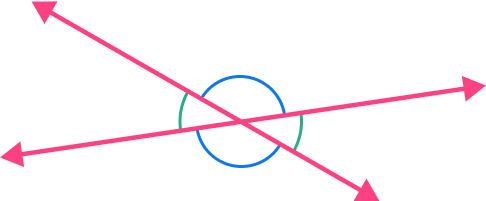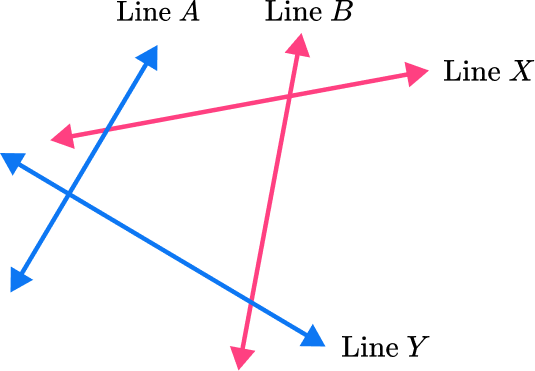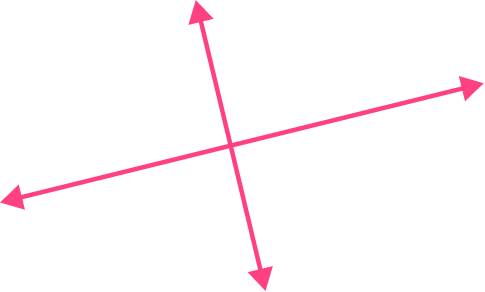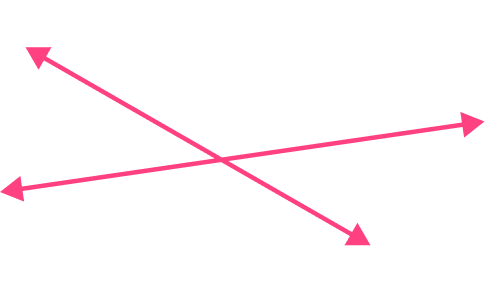High Impact Tutoring Built By Math Experts
Personalized standards-aligned one-on-one math tutoring for schools and districts
Perpendicular lines
Here you will learn about perpendicular lines, including what they are and how to identify them.
Students will first learn about perpendicular lines as part of geometry in 4th grade.
What are perpendicular lines?
Perpendicular lines are lines that intersect to form 90^{\circ} angles (right angles).
In diagrams, right angles are often marked with a small square at the point where the two lines intersect. This notation helps us to quickly identify them as perpendicular lines.
For example,

Not all intersecting lines are perpendicular. If the lines do not meet at a 90-degree angle, they are not perpendicular. Furthermore, lines that never meet, known as parallel lines, also do not qualify as perpendicular.
Perpendicular lines are seen in many common 2D shapes and are essential for constructing shapes like squares and rectangles.
For example,
Each side of a square is perpendicular to the adjacent sides (the sides that touch).
This is why the corners of a square always form right angles.

Perpendicular lines are vital not only in geometry but also in real life.
For example,
A table top and its legs are perpendicular to each other. Where the table top and the legs meet, a 90^{\circ} angle is formed.

What are perpendicular lines?

Common Core State Standards
How does this relate to 4th grade math?
- 4th Grade – Geometry (4.G.A.1)
Draw points, lines, line segments, rays, angles (right, acute, obtuse), and perpendicular and parallel lines. Identify these in two-dimensional figures
How to identify perpendicular lines
In order to identify perpendicular lines:
- Look for two lines that intersect.
- Decide if the angle formed by the lines is a right angle.
![[FREE] Perpendicular Lines Worksheet (Grade 4 and 5)](https://thirdspacelearning.com/wp-content/uploads/2024/05/Perpendicular-Lines-Worksheet-listing-image.png)
[FREE] Perpendicular Lines Worksheet (Grade 4 and 5)
![[FREE] Perpendicular Lines Worksheet (Grade 4 and 5)](https://thirdspacelearning.com/wp-content/uploads/2024/05/Perpendicular-Lines-Worksheet-listing-image.png)
Use this worksheet to check your grade 4 and 5 students’ understanding of perpendicular lines. 15 questions with answers to identify areas of strength and support!
DOWNLOAD FREE![[FREE] Perpendicular Lines Worksheet (Grade 4 and 5)](https://thirdspacelearning.com/wp-content/uploads/2024/05/Perpendicular-Lines-Worksheet-listing-image.png)
[FREE] Perpendicular Lines Worksheet (Grade 4 and 5)
![[FREE] Perpendicular Lines Worksheet (Grade 4 and 5)](https://thirdspacelearning.com/wp-content/uploads/2024/05/Perpendicular-Lines-Worksheet-listing-image.png)
Use this worksheet to check your grade 4 and 5 students’ understanding of perpendicular lines. 15 questions with answers to identify areas of strength and support!
DOWNLOAD FREEPerpendicular lines examples
Example 1: two lines crossing

- Look for two lines that intersect.
The image shows two lines that intersect (cross).
2Decide if the angle formed by the lines is a right angle.

There are acute angles and obtuse angles formed by the intersecting lines, but no right angles, so these lines are NOT perpendicular.
Example 2: geometric lines
Are line AB and line CD perpendicular?

Look for two lines that intersect.
The image shows two lines, line AB and line CD, that cross.
Decide if the angle formed by the lines is a right angle.
A protractor can be used to measure each angle.

There are four right angles (90^{\circ}) formed by the intersecting lines, so these lines are perpendicular.
Example 3: perpendicular lines in a rectangle
Highlight any sets of perpendicular lines in the rectangle.

Look for two lines that intersect.
Each side of a rectangle is made of a line segment that is part of a line. These lines cross at the vertices of the rectangle (which are also the endpoints of the line segments).

Decide if the angle formed by the lines is a right angle.

The four right angles (90^{\circ}) that make up the corners are formed by the intersecting lines, so these lines are perpendicular.
Example 4: perpendicular lines in a triangle
Highlight any sets of perpendicular lines in the triangle.

Look for two lines that intersect.
Each side of a triangle is made of a line segment that is part of a line. These lines cross at the vertices of the triangle.

Decide if the angle formed by the lines is a right angle.

A perpendicular triangle is a triangle where one interior angle is 90^{\circ} . In other words, a perpendicular triangle is a right-angled triangle.
In this triangle, there are acute angles and obtuse angles formed by the intersecting lines, but no right angles, so these lines are NOT perpendicular.
Example 5: perpendicular lines in the real world
Find a set of perpendicular lines.

Look for two lines that intersect.
There are many lines that cross. An example is:

The sidewalk can be represented by a straight line, and the side of the store can be represented by a straight line.
Decide if the angle formed by the lines is a right angle.

There are four right angles (90^{\circ}) formed by the intersecting lines, so the sidewalk is perpendicular to the side of the store.
The picture below shows some of the other sets of perpendicular lines:

Example 6: perpendicular lines in real life
Find a set of perpendicular lines.

Look for two lines that intersect.
There are many lines that cross. An example is:

The top of the door can be represented by a straight line, and the side of the door can be represented by a straight line.
Decide if the angle formed by the lines is a right angle.

There are four right angles (90^{\circ}) formed by the intersecting lines, so the top of the door is perpendicular to the side of the door.
The picture below shows some of the other sets of perpendicular lines:

Teaching tips for perpendicular lines
- Worksheets that show a variety of 2D shapes or real world pictures can be useful for this skill, along with everyday 2D and 3D objects found in the classroom. Encourage students to look for and identify perpendicular lines in a variety of places.
- Provide practice problems that go beyond asking students to just identify them but also ask them to create and explain perpendicular lines in a variety of scenarios. This shows students’ knowledge of the topic on multiple levels.
- Encourage students to measure different angles formed by two intersecting lines with a protractor and use the measurement to explain whether or not the lines are perpendicular.
- Drawing perpendicular lines is a fundamental skill in geometry. Whether you’re working on a construction project or solving math problems, understanding how to draw these lines accurately is crucial. Support students to draw perpendicular lines with a protractor.
Easy mistakes to make with perpendicular lines
- Confusing parallel and perpendicular lines
Since they are often introduced together, in the beginning it is easy for students to confuse these two vocabulary words. With enough practice and real world application, students will learn the difference.
- Mixing up a third or fourth line
When more than two lines are shown, it can be hard to consider the relationship of only two lines at a time. Encourage students to highlight where two lines intersect or to physically cover the other lines, when deciding if two lines are perpendicular or not.
For example,
If given and asked about Line A and Line Y…
Students can…
Highlight two lines: Cover the extra lines:

Related lines lessons
Practice perpendicular lines questions
1. Which of the given lines look perpendicular?









These two lines look like they form right angles where they intersect.
Measuring the angle with the protractor proves that they do, and so these lines are perpendicular.
2. Which of the given lines look perpendicular to each other?

line A and line Y

line B and line X

line A and line B

line X and line Y


The angles formed by line A crossing line Y look like right angles.
Measuring the angle with the protractor proves that they are, and so these lines are perpendicular.
3. Which shape has perpendicular lines?









A right triangle is formed when the base and the height are perpendicular to each other – creating a right angle (90^{\circ}).
4. Which shape DOES NOT have perpendicular lines?








The lines that make up this trapezoid form acute and obtuse angles, but no right angles (90^{\circ}).

This trapezoid DOES NOT have perpendicular lines.
5. Which lines on the ice cream look perpendicular?









Measuring with the protractor proves that there are four right angles (90^{\circ}) formed by the crossing lines, so these lines are perpendicular.
6. Which lines on the barn look perpendicular?









Measuring with the protractor proves that there are four right angles (90^{\circ}) formed by the crossing lines, so these lines are perpendicular.
Perpendicular lines FAQs
The symbol used to represent perpendicular lines is ⊥.
This is where lines meet and form a point and an angle. For perpendicular lines, a 90 degree angle is formed.
Perpendicular lines intersect at right angles ( 90^{\circ} )with one another. You can check with a protractor if an angle is a right angle.
The perpendicular relationship between lines or line segments is something students will continue to examine as they progress through middle and high school. When studying triangles, they will explore perpendicular bisectors.
When studying circles, they will explore the relationship between the tangent line and the radius of a circle. As they move through algebra they will calculate the slope and find the equation of perpendicular lines.
The next lessons are
- Angles
- Angles in parallel lines
- 2D shapes
- Quadrilateral
- Triangle
Still stuck?
At Third Space Learning, we specialize in helping teachers and school leaders to provide personalized math support for more of their students through high-quality, online one-on-one math tutoring delivered by subject experts.
Each week, our tutors support thousands of students who are at risk of not meeting their grade-level expectations, and help accelerate their progress and boost their confidence.

Find out how we can help your students achieve success with our math tutoring programs.
[FREE] Common Core Practice Tests (3rd to 8th Grade)
Prepare for math tests in your state with these 3rd Grade to 8th Grade practice assessments for Common Core and state equivalents.
Get your 6 multiple choice practice tests with detailed answers to support test prep, created by US math teachers for US math teachers!